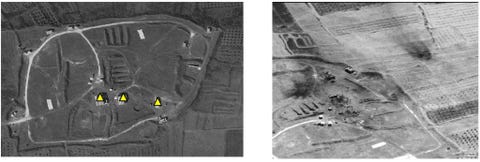
What missiles, where, and why
This weekend the United States and its allies launched a wave of missile strikes designed to cripple Syria’s chemical weapons capability, triggered by the Syrian government’s use of poison gas against civilians in rebel-held areas. Despite worries that Russian military forces deployed in an around Syria to support the government could intervene, Russian forces either did not oppose the strikes or did not detect them.
The strikes were launched in response to news that the Syrian government had used both Sarin and chlorine gas on civilians in the rebel-held town of Douma. Sarin is an organophosphate-based chemical agent that attacks the nervous system, while inhalation of chlorine gas causes respiratory failure. At least 70 civilians, including children, were killed in the attack and hundreds injured.
The three NATO countries worked together to coordinate the wave of strikes. The air strikes were launched against three targets, each involved in Syria’s poison gas program. The first was the Barzah Research and Development Center, located on the outskirts of Damascus. According to Chair of the Joint Chiefs of Staff General Joseph Dunford, Barzah was, “a center for research, development, production and testing of chemical and biological agents.”
Barzan, perhaps because it was near Damascus and within earshot of the Syrian regime, received the majority of the incoming missiles. Seventy six missiles were launched at the R&D center, including 57 Tactical Tomahawk land attack cruise missiles launched from U.S. Navy guided missile cruisers, guided missile destroyers and submarines in waters near Syria. Here's video of the nuclear-powered attack submarine USS John Warner launching a Tomahawk missile that targeted Barzan.
The U.S. Air Force launched 19 Joint Air-to-Service Standoff Missile-Extended Range (JASSM-ER) cruise missiles from B-1B Lancer bombers. The Barzan strike was the combat debut for JASSM-ER, a major Each Tomahawk and JASSM-ER carried a 1,000 high explosive warhead.
Some of the buildings at Barzan remained standing but suffered serious damage and are probably unusable. This open source analysis by Finnish analyst Veli-Pekka Kivimaki that shows the extent of the damage.
The second target was the Hims-Shinshar chemical weapons storage facility, located near Syria’s border with Lebanon. That facility was struck by eight Storm Shadow cruise missiles launched by Royal Air Force Tornado strike jets flying from Cyprus, three Missiles De Croisière Naval (Naval Cruise Missiles) launched from a French Navy frigate in the eastern Mediterranean and two French Air Force launched SCALP missiles.

Him Shinsar chemical weapons storage site before (L) & after (R) strikes by SCALP missiles
French forces struck the third target, the Hims-Shinsahar chemical weapons bunker (above), attacking it with six air-launched SCALP cruise missiles. Storm Shadow, Missiles De Croisière Naval, and SCALP are all basically the same cruise missile, launched from different national platforms. Here's French Ministry of Defence video of Rafale fighters taking off to participate in the strikes, loaded with two SCALP missiles each.
In response, Russia claimed Syrian air defence forces—using Russia-supplied missiles and radar systems—shot down 71 of the 105 missiles. U.S., U.K., and French forces reported zero losses and no cruise missiles shot down. Russia had claimed it would shoot down any missile intruding on Syrian airspace and target their launch locations. Russia’s S-400 “Triumph” surface-to-air missile system is allegedly capable of detecting and destroying cruise missiles but appears not to have intervened in the attack or failed to detect it.
The Friday missile attacks appear to have been a one-time deal and no further strikes are imminent. It remains to be seen if Syrian President Bashar Assad refrains from further use of chemical weapons. The U.S. struck Syria a year ago over the use of poison gas as well and the regime continued to use them. It also remains to be seen how much longer Russian President Vladimir Putin will tolerate western military action against his most important ally in the Middle East.